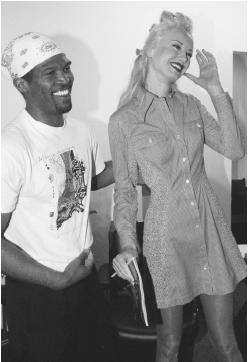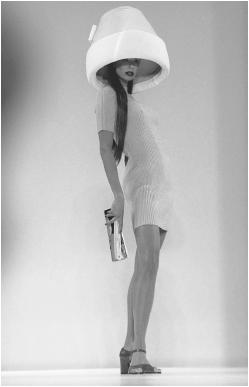Byron Lars - Fashion Designer Encyclopedia
American designer
Born: Oakland, California, 19 January 1965. Education: Studied at the Brooks Fashion Institute, Long Beach, 1983-85; Fashion Institute of Technology, 1986-87; selected to represent USA at the International Concours des Jeunes Créateurs de Mode, Paris, 1986, and at the Festival du Lin, Monte Carlo, 1989. Career: Freelance sketcher and pattern maker, Kevan Hall, Gary Gatyas, Ronaldus Shamask, Nancy Crystal Blouse Co., New York, 1986-91; showed first collection, 1991; first full-scale New York show, 1992; designer, En Vogue fashion collection, from 1993; signed licensing deal with San Siro for Shirttails collection, 1995 (agreement nullified in court, 1997); Cinnabar Sensation Barbie, 1996; signed with Mattel for new line of African American Barbies with designer clothes, 1997; backer pulled funds and firm closed, 1997; launched new collection, Green T, 1999. Exhibitions: Byron Lars' Illustrations, Ambassador Gallery, New

Publications
On LARS:
Books
Stegemeyer, Anne, Who's Who in Fashion, Third Edition, New York, 1996.
Articles
White, Constance C.R., "Rookie of the Year," in WWD, 24 April 1991.
Washington, Elsie B., "Now: Brothers on Seventh Avenue," in Essence, November 1991.
Gerber, Robert, "Byron Lars: Elmer Fudd Fab," in Interview (New York), December 1991.
"Byron Takes Off," in WWD, 15 April 1992.
Schiro, Anne-Marie, "The Sweet Smile of Success," in the New York Times, 7 June 1992.
Darnton, Nina, "The Rainbow Coalition," in Newsweek, 13 July 1992.
Walt, Vivienne, "From Rags to Riches," in the San Francisco Examiner, 9 August 1992.
Piaggi, Anna, "By Air," in Vogue (Milan), August 1992.
Jaffe, Deborah, "Great Style," in Elle (New York), September 1992.
"Working It!" in Essence, September 1992.
Baker, Martha, "(Byronic) Poses," in New York, 12 October 1992.
Donovan, Carrie, and Ruven Afanador, "New York," in the New York Times Magazine, 1 November 1992.
Rubenstein, Hal, "Return to Gilligan's Island, " in the New York Times Magazine, 17 January 1993.
Donovan, Carrie, and Mark Peterson, "It's Lyrical on Seventh Avenue," in the New York Times Magazine, 28 March 1993.
Praeger, Emily, "Neither Virgin Nor Siren," in the New York Times, 14 November 1993.
Bellafante, Ginia, "En Vogue in Vogue?" in Time, 6 December 1993.
MacIntosh, Jeane, "His Dance Cards are Full," in DNR, 28 February 1994.
Johnson, Eunice W., "Spotlightin' Legs," in Ebony, April 1994.
Houston, Ruth, "The All-Important Jacket," in Black Elegance, April 1994.
Menkes, Suzy, "A Touch of Modern Exotica," in the New York Times, 24 April 1994.
Dunn-Lee, Ionia, "Well Suited," in Black Elegance, October 1994.
White, Constance C.R., "Patterns," in the New York Times, 28February 1995.
——, "Patterns," in the New York Times, 4 April 1995.
"New York: Byron Lars," in WWD, 4 April 1995.
White, Constance C.R., "Fur Tradition Versus Fur Fun," in the New York Times, 23 May 1995.
——, "Vision for Changing Times," in the New York Times, 4November 1995.
——, "Patterns," in the New York Times, 23 January 1996.
——, "Three Successes, and So American," in the New York Times, 3 April 1996.
White, Renee Minus, "Byron Lars Designs for Dolls—Barbies and Real Ones," in the New York Amsterdam News, 20 April 1996.
Dunn-Lee, Ionia, "Fashion Innovators on Seventh," in Black Elegance, September 1996.
"Bryon Lars Sues San Siro Over Contract, Trademark," in DNR, 27December 1996.
"Byron's Secret," in WWD, 18 February 1997.
"Byron Loves Barbie," in WWD, 7 May 1997.
Gite, Lloyd, "Breaking into the Fashion Biz: Career Opportunities," in Black Enterprise, June 1997.
Williamson, Rusty, "Byron Lars Comes Back with Spring Green TLine," in WWD, 20 July 2000.
Williamson, Rusty, "Back in the New York Groove; Hot 1990s Designer Byron Lars…," in WWD, 3 August 2000.
***
The career of Byron Lars took wing with his fall 1992 collection inspired by legendary aviatrix Amelia Earhart, but Lars had already been one of the most closely watched and praised newcomers in New York for several years. Mary Ann Wheaton, who worked with Patrick

The fall 1992 collection, Lars' first full-scale New York show, consolidated his reputation (and, not coincidentally, his business circumstances, including backing from C. Itoh & Company) and was built on the same strengths that had characterized his earlier work. In an interview in Essence (September 1992), Lynn Manulis, president of Martha International (which became one of the first stores to carry Lars' work), said, "It was the best and most original collection that happened during the entire fashion week." Lars also attracted the attention of dance legend Merce Cunningham, with whom he became friends.
Appropriating from menswear, with a special interest in the men's dress shirts and in stripes and patterns especially associated with menswear, melding isolated elements of exaggeration with conventional dress in a dry irony, and responding to high fashion and street influence, Lars developed a signature style while still in his twenties. According to Anne-Marie Schiro ( New York Times, 7 June 1992), stores "love his clothes, which can be quirky yet classic, streetwise but never vulgar. His inspiration may come from baseball or aviation, from rappers or schoolgirls. And the accessories are outrageous: caps with oversize crowns and two foot-long peaks, lunch boxes or boom boxes as handbags. They make you smile."
Designer Jeffrey Banks called Lars "the African-American Christian Francis Roth," relating the former's incongruity with the latter's paradoxes of sophisticated innocence in clothing. Roth and Lars share yet another characteristic: they are both consummate masters of the cut, enjoying the construction of the garment almost in the manner of the couture. Lars is not merely making a joke of men's shirts cross-dressed for women, but took the shirttail as a constructive element, reshaped the bust, and deconstructed the shirt to be worn by a woman. It is as much a tour de force in construction as it is an apt idea of 1990s gender transaction. If Lars' clothes were merely facetious, they would succeed as great fun; but they succeed as great fashion because they are beautifully cut.
In adapting menswear, Lars is attentive to feminine outcomes, offering a kind of enhanced sensuality in the presence of male and female in one garment. In many instances, peplums emphasize waist and hips (but not with the 1980s power look), and the sartorial nuancing of shirt and jacket for women directs attention to a broadened expanse of the bust. Often including even men's ties, the result is unequivocally feminine when Lars includes a built-in bra for shaping. Even as he used airplane motifs in textiles in his epochal fall 1992 collection, his fantasy was not a little boy's—aviator jackets had a curvaceous femininity approximating Azzedine Alaïa while shorts, short skirts, and leggings emphasized the female. A duck hunter's outfit in plaid (with a duck decoy made into a handbag), seemingly destined for the L.L. Bean catalogue before a perverse, savvy drollery rendered it chic, and it was featured in the Tribute to the Black Fashion Museum exhibition at the Fashion Institute of Technology, New York, in spring 1992.
Even before the Earhart collection, Lars was influenced by the 1940s. His twists of menswear in the best Rosie-the-Riveter tradition and his fascination with the sarong recall the period. Both shirts and sarongs depended upon tying, a sense of the improvised wrap, that the designer built into the garment. In this, Lars seemed an antecedent in Claire McCardell, whose lifelong interest in casual wraps is similar to Lars' fascination with the shaping and informality afforded by tying. He has also been influenced by pop singers, such as the 1993 En Vogue collection, inspired by the group of the same name. The following year, he created a collection based on African themes; the next, 1995, he had fun with fur, joining other designers such as Yeohlee Teng, Ben Kahn and various others in designing fur collections; and in 1996 Mattel asked Lars to design a collectible Barbie doll, complete with her own fashion wardrobe. His collection that year was a result of being inspired by Barbie, with charcoal gray and cocoa brown colors gracing the line. The Barbie foray proved so successful Mattel asked Lars in 1997 to develop an entire line of African American Barbie dolls, all dressed in designer duds. The same year Lars negotiated with Victoria's Secret to design a collection of sexy, fun cotton lingerie separates and silk robes bearing the firm's logo.
Unfortunately for Lars, the walls came crashing down in late 1997 despite a slew of promising licensing deals. After his financial backing was withdrawn, Lars had little more than the Mattel Barbie collaboration to keep him going. Commenting on the dry period to Women's Wear Daily (20 July 2000), "I freelanced with lots of different types of companies and stretched my creative wings." Yet the times were far from rosy, and he learned a tough lesson on licensing deals. "I'd rather flip burgers at McDonald's than go through that again," he declared. Lars did, however, orchestrate a comeback with a new funky collection in 1999, called Green T, with his name conspicuously absent from the label. "With Green T, we intentionally left my name off the label because we wanted to see if it could fly without a designer angle. We just wanted to do a really great product with design integrity at a really great price."
Lars is only one of many African American designers achieving prominence in New York in the last decade. Others include C.D. Greene, Gordon Henderson, Michael McCollum, Tracy Reese, and Kevin Smith, all inspired by the works of previous designers such as Stephen Burrows, Patrick Kelly, Thierry Mugler, and Willi Smith. If still considered a prodigy today, since he is only in his thirties, Byron Lars is making clever yet important clothes, wearable ideas, wondrous social transplants and mutations, and some of the most sensitively and sensuously cut garments in America.
—Richard Martin;
updated by Daryl F. Mallett
Owen James
Comment about this article, ask questions, or add new information about this topic: